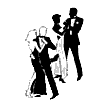 |
ROUND DANCING — CHOREOGRAPHED BALLROOMEDUCATIONAL ARTICLESMAJOR SECTIONS: Figures | Articles | Links | Alph. Index | Search | Home |
|
|
SKIING THROUGH THE FOXTROTby Harold & Meredith Sears We were visiting my sister and brother-in-law recently, and he was reminiscing about first learning to snow ski. He was told to flex this knee, hold your shoulders like that, and probably tuck your tongue in your left cheek just so. He felt distracted and awhirl with all of the little details, and then someone told him, "You want to feel as though you are dancing with the mountain." You meet the slope, the moguls, and the turns with a flexibility and an intimacy; you give, sway, bank, and soar. That's how you ski. Never mind putting one shoulder here and the other hip there. Then, a year or two ago, we heard a couple compare the foxtrot to "cross-country skiing, up and down gentle rolling hills. So, as you ski, sometimes there are bigger hills, and sometimes there are smaller hills, but you propel yourself across -- enjoying the nice, fresh, crisp winter's air." These images do evoke some of the feel of the foxtrot. It does move out. It travels, and it has a floating, gentle kind of rise and fall, as it soars to the left and then to the right, round and round the hall. More often, we associate rise and fall with waltz, where we have frequent closing steps that cause us to lower dramatically, up the side of one mountain and then down into the adjacent valley. Foxtrot consists of many passing steps that keep us on the balls of our feet and keeps us up and moving over those "rolling hills."Some of the figures that contribute best to the soaring, skiing feel of the foxtrot are the weaves. The promenade weave begins in semi-closed or promenade position, of course, and begins with a slow forward step with the trail feet. This step puts us up, with straight knees (not locked) and a bit on the balls of our feet, and we stay up there, as we glide through the forward, side, back, back, side, forward (lower now to prepare for the next figure), all the while turning through a full left-face rotation. I can feel the powdery snow in my face, as I sail over hill and vale. Or let's get into closed position, again with trail feet free, and sparkle through a natural weave. We can separate the natural weave into two parts, an open natural turn followed by a weave ending. For the man, the first measure is forward on the right, beginning to turn right face. Then step side and forward with the left turning to face reverse and wall. Use left side stretch here and left side lead. Think of "banking" into a right with the right edges of your skis biting into the smooth surface. By the way, one of the important things you are doing here is "cutting off" the woman; you are stepping right in front of her, preventing her from stepping forward, and so leading her heel turn. Finally, step back with the right, now with right side lead, in a tight contra banjo position (she steps forward L here). The weave ending begins with a back L, changing to right side stretch, back R beginning to turn left face and leading the woman into closed position. Step side and forward L with left side stretch turning, and finally step forward R in contra banjo facing line and wall. Right side stretch is the same as left body sway, so this weave ending has a kind of rocking sway change to it. You step back L with left sway (body inclined or tilted left), back R turning to closed position with no sway, side L beginning to develop right sway, and forward R with full right sway. I got entangled in some of the little details this time, but can you stand back and feel the smooth glissade to the right and then to the left? A couple of years ago, Kay and Joy Read did a workshop in which they talked about "extending" the weaves in foxtrot. Now, a round dancer can't very well do that if the choreographer didn't do it first, but the idea does build on our vision of the foxtrot as a traveling, soaring style of dance. Instead of a simple natural weave, let's extend it by inserting a measure of four, quick back steps. Do the open natural turn. You are in contra-banjo. Now step back, four quicks. The cue might be "bounce back four." You might insert a lock, sway change, and back. Finish with the weave ending. We have created a four-measure figure with a sweeping curve, a little rush over a couple of moguls, a pause to admire the scenery, another broad curve, and then I'm sure that the choreography will carry us down the remainder of the slope and home. Can you mentally picture a running natural weave with a tumble ending (two measures; eight quicks) and then back to a throwaway oversway? The Foxtrot is a dance rhythm that progresses. There is some rise and fall, but the dancers are up most of the time. The steps are mostly passing steps. We sway into the turns: to the left, to the right. Do you get a bit of the feel of skiing? From the the Dixie Round Dance Council (DRDC) Newsletter, August 2005.
If you would like to read other articles on dance position, technique, styling, and specific dance rhythms, you may visit the article TOC. Past DRDC Educational Articles archived here. Go beyond this site. Find other references on our Sources and Links pages.
|
 |
|
|
Page last revised